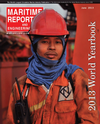
Page 37: of Maritime Reporter Magazine (June 2013)
Annual World Yearbook
Read this page in Pdf, Flash or Html5 edition of June 2013 Maritime Reporter Magazine
www.marinelink.com 37standard. Most vessels under 400 gross tonnage are likely already in compli-ance with the standard as the majority of these vessels operate using solely distil-late fuel oil that meets the Annex VI (Re- vised) ECA fuel oil sulfur limit. The total estimated costs in 2030 are approximately $3.1 billion. These costs are expected to accrue initially to the owners and operators of affected ves- sels when they purchase engines, vessels and fuel. These owners and operators are expected to pass their increased costs on to the entities that purchase international marine transportation services, in the form of higher freight rates. Ultimately, these costs will be borne by the Þ nal con- sumers of goods transported by affected vessels in the form of higher prices for those goods.With regard to market-level impacts, the EPA estimates that compliance would increase the price of a new vessel by 0.5 to 2%, depending on the vessel type. The price impact on the marine transportation services sector would vary, depending on the route and the amount of time spent in waterways covered by the engine and fuel controls. For example, the EPA esti- mated that the cost of operating a ship in liner service between Singapore, Seattle, and Los Angeles/Long Beach, which in- cludes about 1,700 NM of operation in waterways covered the EMC, would in-crease by about 3 percent. For a contain-er ship, this represents a price increase of about $18 per container, assuming the total increase in operating costs is passed on to the purchaser of marine transpor- tation services. The per passenger price of a seven-day Alaska cruise on a ves- sel operating entirely within waterways covered by the EMC is expected to in-crease about $7 per day. Ships that spend less time in covered areas would experi-ence relatively smaller increases in their operating costs and the impact on freight prices is expected to be smaller. This analysis of the economic im-pacts relies on the estimated engineering compliance costs for engines and fuels. These costs include hardware costs for new U.S. vessels, to comply with the Tier 2 and Tier 3 engine standards, and for existing U.S. vessels to comply with the MARPOL Annex VI requirements for existing engines. There are also hardware costs for fuel switching equip-ment on new and existing U.S. vessels to comply with the 1.0% fuel sulfur limit; the cost analysis assumes that 32% of all vessels require fuel-switching equip-ment to be added (new vessels) or retro-Þ t (existing vessels). Also included are expected increases in operating costs for U.S. and foreign vessels operating in the U.S. ECA and U.S. internal waters. These increased operating costs include changes in fuel consumption rates and increases in fuel costs.Estimated price impacts for a sample of engine-vessel combinations are set out in Table 2 (see previous page), for medium speed engines, and Table 3 (see previous page), for slow speed engines. These are the estimated price impacts associated with the Tier 3 engine stan- dards on a vessel that will switch fuels to comply with the fuel sulfur requirements while operating in the waterways cov-ered by EMC, for all years, beginning in 2016.The estimated price impacts for Tier 2 vessels is substantially lower, given the technology that will be used to meet the Tier 2 standards is much less expensive. Because the standards do not phase in, the estimated price impacts are the same for all years the Tier 2 standards are re- quired, 2011 through 2015. The EPA maintains that these estimated price impacts for Tier 2 and Tier 3 ves- sels are relatively small when compared to the price of a new vessel. A selection of new vessel prices is provided in Table 4; these range from about $40-$480 mil-lion. The program price increases range MR #6 (34-41).indd 37MR #6 (34-41).indd 376/3/2013 3:44:50 PM6/3/2013 3:44:50 PM

 36
36

 38
38
